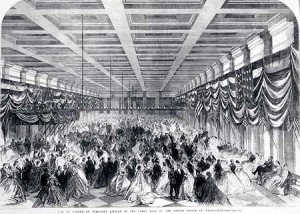The List: From Ballroom to Hospital, Five Lives of the Old Patent Office Building
Take a look back in time and learn the five lives of the old Patent Office Building
/https://tf-cmsv2-smithsonianmag-media.s3.amazonaws.com/filer/20110727120004patent-office-civil-war.jpg)
The old Patent Office Building in Washington, D.C. covers an entire city block, and currently houses not just one, but two museums as well as an archive gallery: The Smithsonian American Art Museum, the National Portrait Gallery and the Lawrence A. Fleischman Gallery of the Archives of American Art.
Poet Walt Whitman called it the “noblest of the Washington buildings,” and it was modeled in part after the Parthenon in Athens, Greece. City planner Pierre L’Enfant originally intended the building to house a “church of the Republic,” but although the structure has survived several transformations, it never actually became a church. This week, the American Art Museum’s deputy director emeritus Charles Robertson will lead a now fully-booked tour describing the uses of the historic building during the Civil War. But since the museum is only taking wait-list requests for the popular tour, we took a look back in time to show you the five lives of the old Patent Office Building.
1. Patent Office: Bet you never would have guessed, but the Patent Office moved into the building in 1842, even before the structure was entirely completed. It granted patents from the building until 1932.
2. Civil War Hospital: During the Civil War, which lasted from 1861 to 1865, the Patent Office Building served as a hospital for wounded soldiers, in addition to housing a temporary barracks and a morgue. American Red Cross founder and nurse Clara Barton worked there as a volunteer nurse. Walt Whitman, who also served as a Civil War nurse, often came to the building to read to the wounded.

President Lincoln's second inaugural ball, from the Illustrated London News, April 8, 1965. Courtesy of the National Portrait Gallery.
3. Ballroom: In March of 1865, the building was host to President Lincoln’s second inaugural ball, the first time a government had been used for the event. A ten dollar ticket admitted “one gentleman and two ladies” to the celebration.
4. Civil Service Commission Offices: After the Patent Office left the historic building in 1932, the Civil Service Commission took over. The commission administers the country’s civil service, which is composed of government employees not in the military. It was renamed as the Office of Personnel Management in 1978.
5. Museum: The Patent Office Building was given to the Smithsonian Institution by Congress, and was restored from 1964 to 1967. In January of 1968, the building opened to the public and today houses two museums, the American Art Museum and the National Portrait Gallery (which is currently hosting a series of interviews with curators and historians about the people and events of the Civil War).